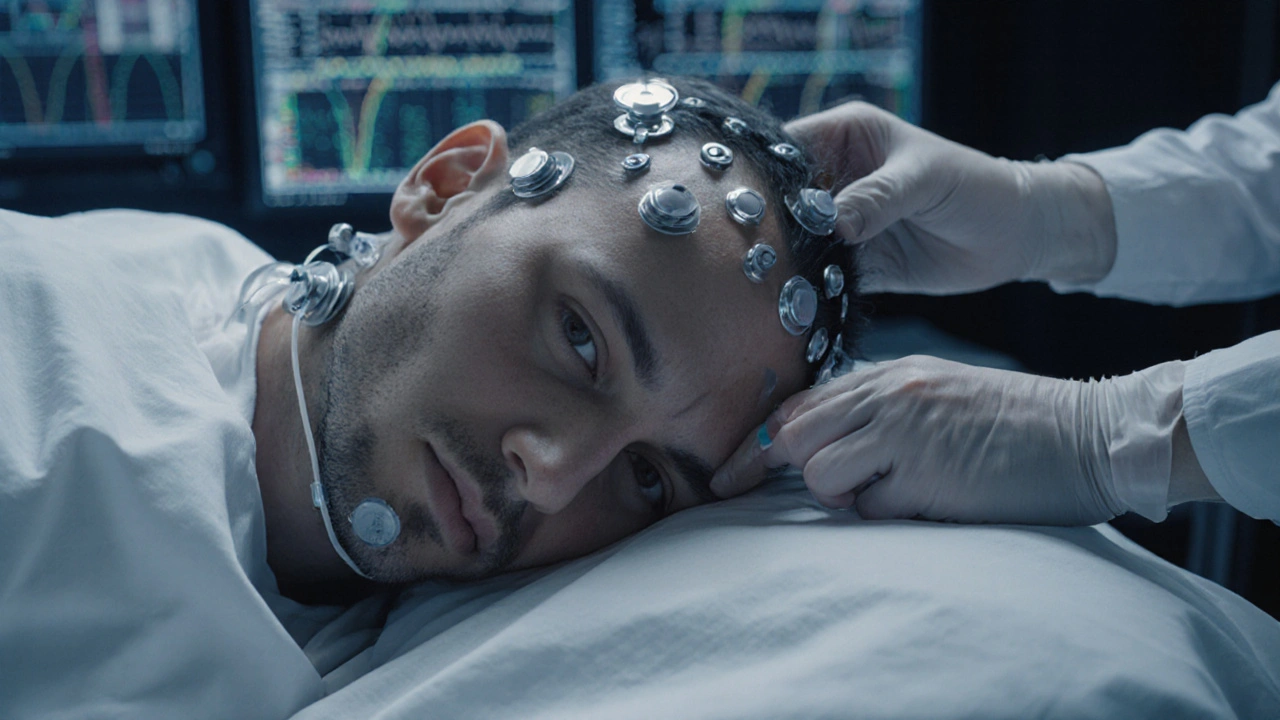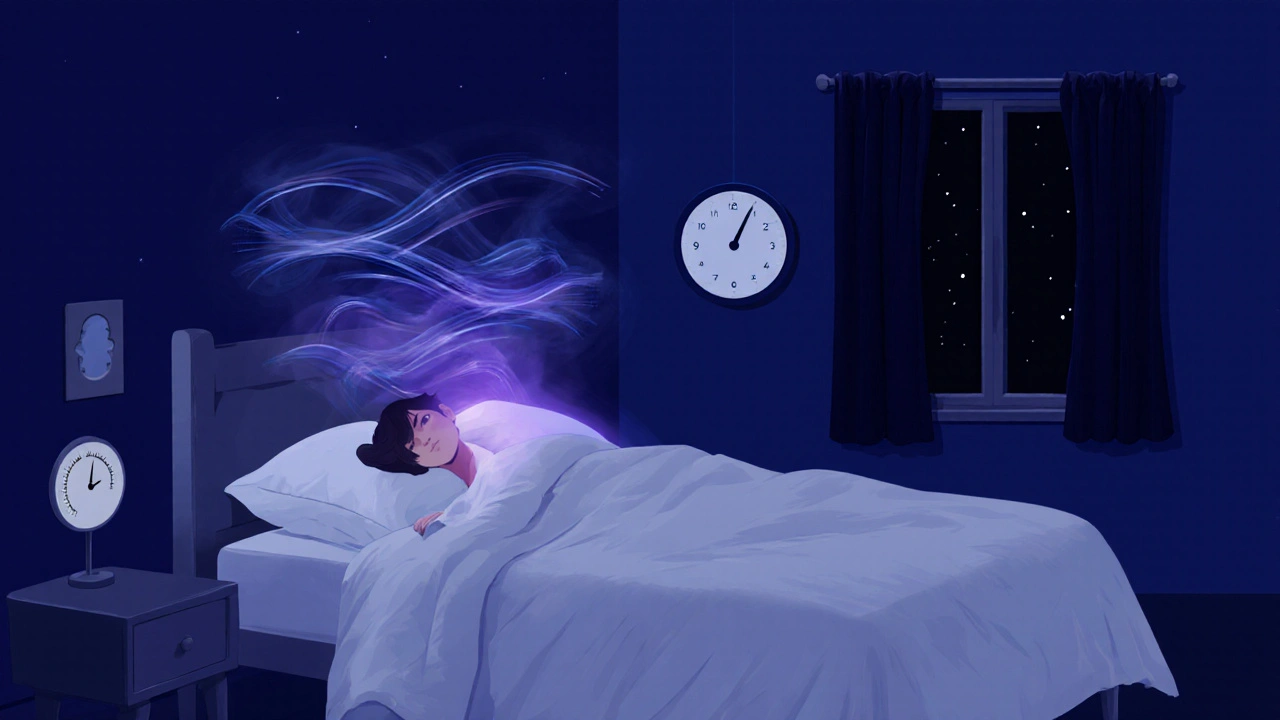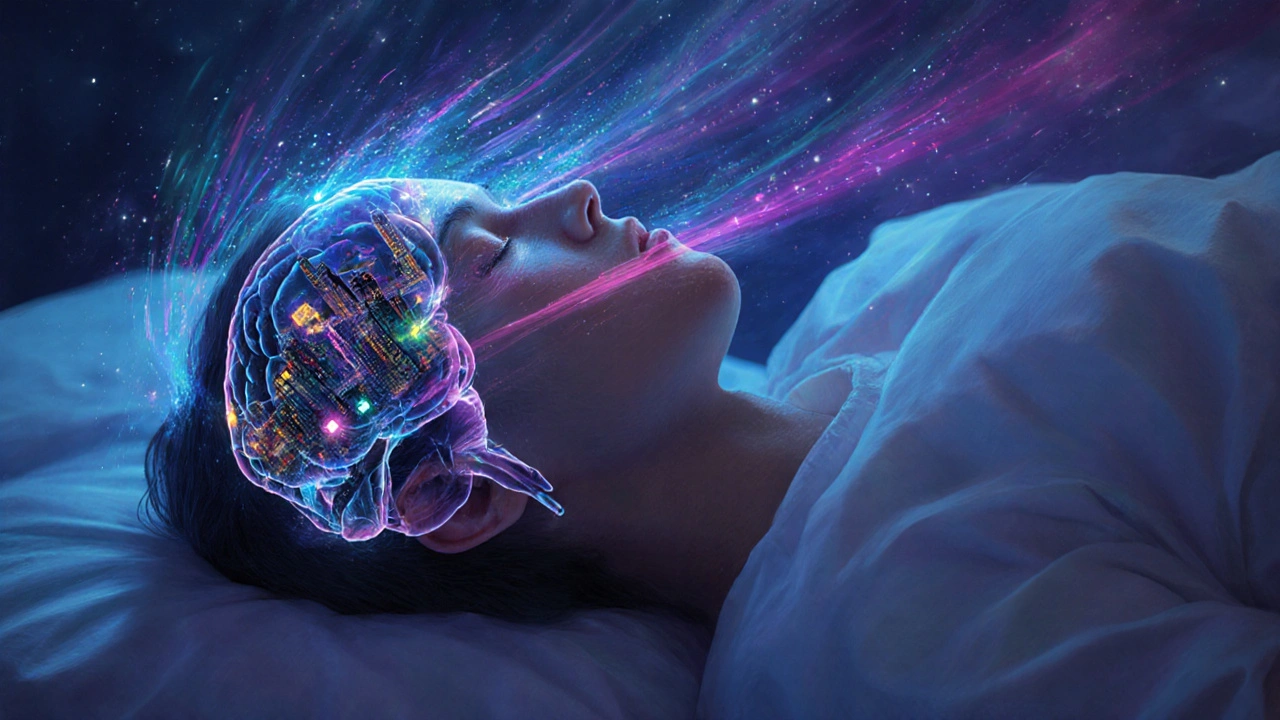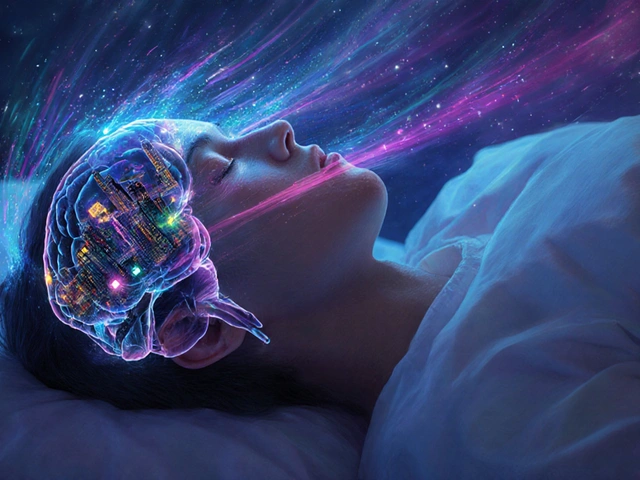REM Sleep Duration Calculator
Your REM Sleep Estimate
REM sleep is the stage most people think of when they hear the word "sleep" - it’s when eyes dart, dreams run wild, and the brain lights up like a city at night. Understanding what really happens during this phase helps you see why a good night's rest matters for mood, learning, and overall health.
Key Takeaways
- REM sleep makes up about 20‑25% of an adult’s total sleep time.
- During REM, the brain shows activity patterns similar to waking, while the body stays mostly still.
- Dreaming, memory consolidation, and emotional regulation all rely heavily on REM cycles.
- Age, alcohol, certain medications, and sleep disorders can shrink REM duration.
- Polysomnography is the gold‑standard tool for measuring REM and other sleep stages.
What Is REM Sleep?
When you close your eyes, you don’t just drift into a uniform state. Your brain cycles through distinct stages. Rapid Eye Movement is the hallmark of the sleep phase known as REM sleep, during which the eyes move quickly under the lids, muscle tone drops, and vivid dreaming peaks. The term was coined in the 1950s after researchers noticed these eye bursts during polysomnographic recordings.
In REM, the brain’s electrical activity-especially theta and beta waves-mirrors that of wakefulness. Meanwhile, the body experiences atonia, a protective paralysis that prevents us from acting out dreams. This unique blend of high mental activity and low physical movement makes REM both fascinating and essential.
How REM Fits Into the Sleep Cycle
Sleep isn’t a single block; it’s a series of cycles lasting roughly 90‑110 minutes. Each cycle starts with light N1 sleep, deepens into N2, then dives into the restorative NREM sleep (Non‑Rapid Eye Movement) stages, and finally peaks with REM.
Early in the night, REM periods are short-often 5‑10 minutes. As the night progresses, they lengthen, sometimes hitting 30‑40 minutes in the early morning. This pattern explains why you’re more likely to remember a vivid dream if you wake up during or right after a REM episode.
Brain Activity During REM
The brain’s “default mode network” lights up during REM, supporting internal thought streams and imagination. The pons a brainstem region that generates the REM signal sends bursts of acetylcholine, a neurotransmitter that stimulates cortical activity while inhibiting norepinephrine, which normally keeps us alert.
As a result, the prefrontal cortex-responsible for logical reasoning-shows reduced activity, while limbic structures like the amygdala remain active. This explains the emotional intensity of REM dreams and the often bizarre, illogical storylines.

Why We Dream in REM
Dreaming doesn’t stop outside REM, but it’s most vivid then. One leading theory, the emotional processing hypothesis, suggests that REM lets the brain rehearse stressful events in a low‑risk environment, helping to desensitize emotional memories.
Another view, the memory consolidation hypothesis, argues that REM integrates new experiences with existing knowledge networks, especially for procedural and emotional memory. The activation of the hippocampus during REM supports this idea, as it helps bind fragmented memory traces into coherent narratives.
REM’s Role in Memory and Learning
Researchers at Stanford and Harvard have shown that participants who get a full night of REM after learning a task perform better on later tests. This benefit is strongest for tasks involving spatial navigation, language acquisition, and motor skills.
During REM, the brain replays patterns of neural firing observed during wakeful learning, a process called memory consolidation the strengthening and integration of new memories into long‑term storage. Disrupting REM-by alcohol, certain antidepressants, or sleep apnea-can impair this consolidation, leading to poorer recall and reduced creative problem‑solving.
Factors That Influence REM Amount
- Age: Newborns spend up to 50% of sleep in REM; adults average 20‑25%.
- Circadian rhythm: The body’s internal clock, regulated by melatonin, dictates when REM peaks, typically toward the end of the night.
- Substances: Alcohol suppresses REM early in the night, causing a rebound later. Caffeine has a mild REM‑reduction effect.
- Medications: Some SSRIs lower REM density, while nicotine can fragment REM periods.
- Sleep disorders: Conditions like obstructive sleep apnea interrupt REM, leading to daytime fatigue.
Understanding these influences helps you tweak habits-like limiting alcohol before bed-to protect your REM quota.
Common REM‑Related Issues
When REM goes awry, you might notice vivid nightmares, REM sleep behavior disorder (RBD), or excessive daytime sleepiness. In RBD, the atonia that normally keeps you still fails, causing people to “act out” dreams-sometimes dangerously. RBD can be an early warning sign for neurodegenerative diseases such as Parkinson’s.
Sleep paralysis a temporary inability to move upon waking or falling asleep, often linked to disrupted REM cycles is another REM‑related phenomenon. It usually lasts seconds to a couple of minutes but can be unsettling.
Addressing these issues often involves improving sleep hygiene, treating underlying conditions, and, in severe cases, medication under a neurologist’s guidance.

Measuring REM: Polysomnography
The definitive way to track REM is through polysomnography a sleep study that records brain waves, eye movements, muscle tone, heart rate, and breathing. Technicians place electrodes on the scalp (EEG), around the eyes (EOG), and on the chin (EMG). The resulting data show clear REM signatures: low-amplitude mixed-frequency EEG, rapid eye movements on the EOG, and near‑zero EMG activity.
Home sleep tests are improving, but they often miss the nuanced eye‑movement data needed for precise REM scoring. For most clinical purposes, an overnight stay at a sleep lab remains the gold standard.
REM vs. NREM: Quick Comparison
| Feature | REM Sleep | NREM Sleep |
|---|---|---|
| Eye Activity | Rapid movements (EOG spikes) | Still eyes |
| Muscle Tone | Severe atonia (except diaphragm) | Variable, higher tone |
| Brain Waves | Low‑amplitude, mixed frequency (theta/beta) | Delta waves dominate deep stages |
| Dream Intensity | Vivid, storyline‑rich | Less vivid, fragmented |
| Proportion of Night | 20‑25% total, increases later | 75‑80% total, dominates early night |
| Key Neurotransmitters | High acetylcholine, low norepinephrine | Higher norepinephrine, serotonin |
| Functions | Memory consolidation, emotional regulation | Physical restoration, growth hormone release |
Tips to Optimize Your REM
- Stick to a consistent bedtime to keep your circadian rhythm steady.
- Avoid alcohol within three hours of sleep; it suppresses early REM.
- Limit caffeine after noon to reduce REM fragmentation.
- Create a dark, cool bedroom-ideal for melatonin production.
- Engage in regular exercise, but finish vigorous activity at least a couple of hours before bed.
- If you suspect a sleep disorder, consult a specialist; treating apnea often restores REM balance.
Frequently Asked Questions
Why do I remember some dreams but not others?
Dream recall is strongest when you awaken directly from REM. If you slip into lighter NREM stages after a dream, the memory fades. Keeping a notebook by the bedside and writing down fragments immediately can improve recall over time.
Can I increase the amount of REM I get each night?
You can’t directly “add” REM, but you can protect it. Prioritizing total sleep time, avoiding substances that suppress REM, and treating sleep apnea are proven ways to let the natural REM cycles expand.
Is dreaming during REM essential for mental health?
While the exact mechanisms are still debated, several studies link reduced REM density with mood disorders like depression and anxiety. REM appears to help process emotional experiences, so preserving it may support emotional resilience.
What is REM sleep behavior disorder and who gets it?
RBD is a condition where the muscle atonia of REM fails, causing people to act out vivid dreams. It’s more common in older adults, especially men, and can precede neurodegenerative diseases such as Parkinson’s or Lewy body dementia.
How does age affect REM sleep?
Infants spend up to half their sleep in REM, which drops to about 20‑25% in healthy adults. Elderly individuals often experience fragmented REM and shorter overall REM periods, partly due to changes in circadian regulation and increased prevalence of sleep disorders.


So you finally decided to dig into REM, huh? It's like the brain's own midnight improv session, where thoughts jump around faster than a caffeinated squirrel. I guess we all love that weird mix of dreaming and brain‑washing, right? Still, the fact that we spend a quarter of our night in this chaotic cinema is kind of poetic, if you ask a philosopher. But hey, if you can blame the brain, you can also blame the alarm clock for stealing the show.
REM sleep isn’t just random fireworks; it’s a meticulously orchestrated phase where the hippocampus consolidates declarative memories while the amygdala processes emotional residues. During this stage, the brain’s cholinergic activity spikes, promoting synaptic plasticity that underlies learning efficiency. Studies using polysomnography reveal that disruptions in REM correlate with deficits in procedural skill acquisition and heightened anxiety levels. Moreover, the surge of neurotrophic factors like BDNF during REM supports neuronal repair and dendritic growth. If you’re aiming for optimal cognitive performance, protecting those 20‑25% REM windows is non‑negotiable. Consistency in sleep schedule, a cool dark environment, and limiting alcohol are proven strategies to safeguard REM density. In short, treat REM like premium fuel for your mental engine-skip it, and you’ll feel the sputter.
Honestly this whole REM hype is just another excuse for people to feel special about their weird dreams you know it’s just brain static and we’re all just staring at the ceiling while it burns through data like a cheap server farm
Yo i gotta say REM is wack but also super important for gettin’ that creative juice flowing dont sleep like a zombie man u need those quick eye movs to level up ur brain
Wake up, get that REM in!
Hey everyone! Just wanted to add that REM isn’t only about dreaming-research shows it plays a key role in emotional regulation, helping us process stress from the day. It’s fascinating how the brain re‑activates emotional memories during this phase, essentially giving us a nightly therapy session. So, if you’re feeling moody, consider checking your sleep hygiene; a solid REM routine can make a huge difference. Keep those bedrooms cool, dark, and tech‑free for the best results!
REM is overhyped and the article is full of sloppy phrasing the brain doesn’t magically “reset” it’s just chemistry stop spreading nonsense
When we stare into the abyss of our own nightly reveries, we confront the paradox of consciousness-REM is both a window and a veil. It allows fragmented narratives to surface, inviting us to interrogate the self without the interference of waking logic. This liminal space can be seen as an unconscious laboratory where identity is continuously tested. If we honor that process, perhaps we can integrate its insights into our waking decisions, bridging the gap between dream and reality. In this sense, REM becomes a bridge rather than a barrier, a subtle whisper urging us toward deeper self‑knowledge.
i cant believe ppl still think REM is just a random thing its a moral duty to respect it and get enough sleep stop being lazy
Fact check: The proportion of REM sleep does indeed decline with age, dropping from roughly 25% in young adults to about 15% in seniors, as confirmed by longitudinal sleep studies. Additionally, alcohol consumption suppresses REM onset, which is why binge drinkers often report fragmented dreaming. The interplay between circadian rhythms and REM architecture is also well‑documented; misaligned melatonin release can shift REM timing. Finally, the glymphatic system ramps up during sleep, particularly in non‑REM, but REM still contributes to waste clearance. So, the article’s points are generally accurate, though a few nuances could be expanded.
Dearest readers, permit me to dramatize the significance of REM sleep: it is the grand theatre upon which the mind stages its nightly productions, replete with tragedy, comedy, and the occasional absurdity. Neglect this act, and one courts cognitive disarray, as though the curtain were drawn before the final act. The empirical evidence, dear audience, unequivocally supports REM’s role in memory consolidation and emotional equilibrium. Let us, therefore, venerate our nocturnal interludes with the reverence they deserve, lest we become actors without scripts.
REM sleep, often romanticized as the realm of vivid dreaming, is fundamentally a neurophysiological process essential for holistic brain health. During REM, the brain exhibits a paradoxical state: cortical activity resembles wakefulness while the body experiences atonia, preventing us from acting out our dreams. This unique configuration facilitates the replay and integration of recent experiences, a mechanism researchers term “memory consolidation.” The hippocampus, in particular, reactivates neural patterns associated with new information, strengthening synaptic connections in the neocortex. Simultaneously, the limbic system processes the emotional valence of those memories, aiding in affect regulation. Neuroimaging studies reveal heightened activation of the amygdala during REM, which may explain why dreams often carry strong emotional tones. Moreover, the cholinergic surge characteristic of REM supports synaptic plasticity, a cornerstone of learning. Disruptions in REM have been linked to mood disorders such as depression and anxiety, suggesting a bidirectional relationship between dream quality and mental health. In addition, animal models demonstrate that REM deprivation impairs performance on tasks requiring procedural memory, underscoring its role beyond mere dreaming. The glymphatic clearance system, though most active in non‑REM, still benefits from REM’s unique circulatory patterns, contributing to metabolic waste removal. Importantly, age‑related reductions in REM proportion correlate with cognitive decline, highlighting the need for age‑appropriate sleep interventions. Lifestyle factors, including chronic stress, alcohol use, and irregular sleep schedules, can blunt REM density, thereby compromising its protective functions. Therapeutic approaches such as cognitive‑behavioral therapy for insomnia (CBT‑I) aim to normalize sleep architecture, often restoring healthy REM cycles. Emerging pharmacological agents targeting the orexin system show promise in enhancing REM without adverse side effects. Ultimately, safeguarding REM sleep is not a luxury but an imperative for maintaining optimal cognitive and emotional resilience throughout life.
Sure, REM is cool, but the article skips the part about how daytime naps can also boost REM without much effort.
Remember, getting enough REM is a simple step toward feeling better each day. Keep your room dark and turn off screens before bed. You’ll notice the difference in mood and focus.
Looks like you’re ignoring the practical tips people keep dropping in the comments-maybe try actually following them instead of just reading about REM.
Don’t be fooled, the real reason the industry downplays REM is because it exposes how our brains are being subtly rewired by hidden algorithms in our devices. Those “sleep trackers” feed us data that keeps us in a state of constant surveillance, manipulating our dream cycles to control behavior. Wake up, question the tech, and protect your unconscious mind from this covert manipulation.